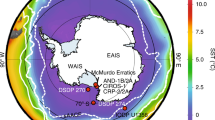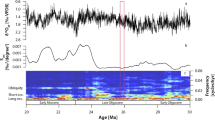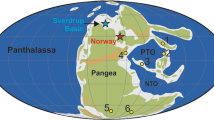Abstract
Major ice sheets were permanently established on Antarctica approximately 34 million years ago1,2,3, close to the Eocene/Oligocene boundary, at the same time as a permanent deepening of the calcite compensation depth in the world’s oceans4. Until recently, it was thought that Northern Hemisphere glaciation began much later, between 11 and 5 million years ago1,2,3,5. This view has been challenged, however, by records of ice rafting at high northern latitudes during the Eocene epoch6,7 and by estimates of global ice volume that exceed the storage capacity of Antarctica8 at the same time as a temporary deepening of the calcite compensation depth ∼41.6 million years ago9. Here we test the hypothesis that large ice sheets were present in both hemispheres ∼41.6 million years ago using marine sediment records of oxygen and carbon isotope values and of calcium carbonate content from the equatorial Atlantic Ocean. These records allow, at most, an ice budget that can easily be accommodated on Antarctica, indicating that large ice sheets were not present in the Northern Hemisphere. The records also reveal a brief interval shortly before the temporary deepening of the calcite compensation depth during which the calcite compensation depth shoaled, ocean temperatures increased and carbon isotope values decreased in the equatorial Atlantic. The nature of these changes around 41.6 million years ago implies common links, in terms of carbon cycling, with events at the Eocene/Oligocene boundary4 and with the ‘hyperthermals’ of the Early Eocene climate optimum3,10,11. Our findings help to resolve the apparent discrepancy between the geological records of Northern Hemisphere glaciation6,7,8 and model results12,13 that indicate that the threshold for continental glaciation was crossed earlier in the Southern Hemisphere than in the Northern Hemisphere.
This is a preview of subscription content, access via your institution
Access options
Subscribe to this journal
Receive 51 print issues and online access
$199.00 per year
only $3.90 per issue
Buy this article
- Purchase on Springer Link
- Instant access to full article PDF
Prices may be subject to local taxes which are calculated during checkout



Similar content being viewed by others
References
Miller, K. G., Wright, J. D. & Fairbanks, R. G. Unlocking the ice house: Oligocene-Miocene oxygen isotopes, eustasy, and margin erosion. J. Geophys. Res. 96, 6829–6848 (1991)
Lear, C. H., Elderfield, H. & Wilson, P. A. Cenozoic deep-sea temperatures and global ice volumes from Mg/Ca in benthic foraminiferal calcite. Science 287, 269–272 (2000)
Zachos, J., Pagani, M., Sloan, L., Thomas, E. & Billups, K. Trends, rhythms, and aberrations in global climate 65 Ma to present. Science 292, 686–693 (2001)
Coxall, H. K., Wilson, P. A., Pälike, H., Lear, C. H. & Backman, J. Rapid stepwise onset of Antarctic glaciation and deeper calcite compensation in the Pacific Ocean. Nature 433, 53–57 (2005)
Holbourn, A., Kuhnt, W., Schulz, M. & Erlenkeuser, H. Impacts of orbital forcing and atmospheric carbon dioxide on Miocene ice-sheet expansion. Nature 438, 483–487 (2005)
Moran, K. et al. The Cenozoic palaeoenvironment of the Arctic Ocean. Nature 441, 601–605 (2006)
Eldrett, J. S., Harding, I. C., Wilson, P. A., Butler, E. & Roberts, A. P. Continental ice in Greenland during the Eocene and Oligocene. Nature 446, 176–179 (2007)
Tripati, A., Backman, J., Elderfield, H. & Ferretti, P. Eocene bipolar glaciation associated with global carbon cycle changes. Nature 436, 341–346 (2005)
Lyle, M., Olivarez Lyle, A., Backman, J. & Tripati, A. Biogenic sedimentation in the Eocene equatorial Pacific—The stuttering greenhouse and Eocene carbonate compensation depth. Proc. ODP Sci. Res. (eds Wilson, P. A., Lyle, M. & Firth, J. V.). 199, 1–35 (2005)
Zachos, J. C. et al. Rapid acidification of the ocean during the Paleocene-Eocene thermal maximum. Science 308, 1611–1615 (2005)
Lourens, L. J. et al. Astronomical pacing of late Palaeocene to early Eocene global warming events. Nature 435, 1083–1087 (2005)
DeConto, R. M. & Pollard, D. Northern Hemisphere glaciation in the early Cenozoic? AGU Fall Meet. abstr. PP21B–1678 (2006)
DeConto, R. M. & Pollard, D. Rapid Cenozoic glaciation of Antarctica induced by declining atmospheric CO2 . Nature 421, 245–249 (2003)
Zachos, J. C., Breza, J. R. & Wise, S. W. Early Oligocene ice-sheet expansion on Antarctica: Stable isotope and sedimentological evidence from Kerguelen Plateau, southern Indian Ocean. Geology 20, 569–573 (1992)
Pekar, S. F., Christie-Blick, N., Kominz, M. A. & Miller, K. G. Calibration between eustatic estimates from backstripping and oxygen isotopic records for the Oligocene. Geology 30, 903–906 (2002)
Lear, C. H., Rosenthal, Y., Coxall, H. K. & Wilson, P. A. Late Eocene to early Miocene ice sheet dynamics and the global carbon cycle. Paleoceanography 19 doi: 10/1029/2004PA001039 (2004)
Shipboard. Scientific Party 2002. Leg 199 Summary. Proc. ODP Init. Rep. (eds Lyle, M., Wilson, P. A., Janecek, T. R.). 199, 1–87 (2002)
Sexton, P. F., Wilson, P. A. & Norris, R. D. Testing the Cenozoic multi-site composite δ18O and δ13C curves: new Eocene monospecific records from a single locality, Demerara Rise (ODP Leg 207). Paleoceanography 21 PA2019 doi: 10.1029/2005PA001253 (2006)
Pagani, M., Zachos, J. C., Freeman, K. H., Tipple, B. & Bohaty, S. Marked decline in atmospheric carbon dioxide concentration during the Paleogene. Science 309, 600–603 (2005)
Wolfe, J. A. in The Carbon Cycle and Atmospheric CO2; Natural Variations Archean to Present (eds Sundquist, E. T. & Broecker, W. S.) 357–375 (Geophys. Monogr. 32, American Geophysical Union, Washington DC, 1985)
Pekar, S. F., Hucks, A., Fuller, M. & Li, S. Glacioeustatic changes in the Early and Middle Eocene (51–42 Ma): shallow-water stratigraphy from ODP Leg 189 Site 1171 (South Tasman Rise) and deep-sea δ18O records. Geol. Soc. Am. Bull. 117, 1081–1093 (2005)
Shipboard. Scientific Party 2004. Leg 207 Summary. Proc. ODP Init. Rep. (eds Erbacher, J., Mosher, D. C. & Malone, M. J.). 207, 1–89 (2004)
Pekar, S. F., DeConto, R. M. & Harwood, D. M. Resolving a late Oligocene conundrum: deep-sea warming and Antarctic glaciation. Palaeogeogr. Palaeoclimatol. Palaeoecol. 231, 29–40 (2006)
Lythe, M. B. & Vaughan, D. G. & the BEDMAP consortium. BEDMAP: a new ice thickness and subglacial topographic model of Antarctica. J. Geophys. Res. 106, 335–351 (2001)
Poulsen, C. J., Pollard, D. & White, T. S. General circulation model simulation of the δ18O content of continental precipitation in the middle Cretaceous: A model-proxy comparison. Geology 35, 199–202 (2007)
Schrag, D. P. et al. The oxygen isotopic composition of seawater during the Last Glacial Maximum. Quat. Sci. Rev. 21, 331–342 (2002)
Shipboard. Scientific Party. Leg 198 Summary. Proc. ODP Init. Rep. (eds Bralower, T. J., Premoli-Silva, I. & Malone, M. J.). 198, 1–148 (2002)
Suganuma, Y. & Ogg, J. G. Campanian through Eocene Magnetostratigraphy of Sites 1257–1261, ODP Leg 207, Demerara Rise (Western Equatorial Atlantic). Proc. ODP Sci. Res. (eds Mosher, D. C., Erbacher, J. & Malone, M. J.). 207, 1–48 (2006)
Pälike, H. et al. The heartbeat of the Oligocene climate system. Science 314, 1894–1898 (2006)
Huybrechts, P. Sea-level changes at the LGM from ice-dynamic reconstructions of the Greenland and Antarctic ice sheets during the glacial cycles. Quat. Sci. Rev. 21, 203–231 (2002)
Acknowledgements
This work used samples provided by the Ocean Drilling Program (ODP). The ODP (now IODP) is sponsored by the US National Science Foundation and participating countries under management of the Joint Oceanographic Institutions (JOI), Inc. We thank the shipboard party of ODP Leg 207, M. Bolshaw, M. Cooper and D. Spanner for help with laboratory work, H. Pälike for making data available; S. Gibbs, K. Moriya, H. Pälike, A. Roberts and T. Tyrrell for discussions and comments on an earlier draft and R. Zeebe for his constructive review. Financial support was provided by NERC in the form of a UK IODP grant to P.A.W. and P.F.S and by NERC and Perkin Elmer in the form of a CASE studentship to K.M.E.
Author information
Authors and Affiliations
Corresponding author
Ethics declarations
Competing interests
Reprints and permissions information is available at www.nature.com/reprints. The authors declare no competing financial interests.
Rights and permissions
About this article
Cite this article
Edgar, K., Wilson, P., Sexton, P. et al. No extreme bipolar glaciation during the main Eocene calcite compensation shift. Nature 448, 908–911 (2007). https://doi.org/10.1038/nature06053
Received:
Accepted:
Issue Date:
DOI: https://doi.org/10.1038/nature06053
This article is cited by
-
The PhanSST global database of Phanerozoic sea surface temperature proxy data
Scientific Data (2022)
-
Mid-Eocene sea surface cooling in the easternmost proto-Paratethys sea: constraints from quantitative temperatures in halite fluid inclusions
International Journal of Earth Sciences (2021)
-
Evidence for ephemeral middle Eocene to early Oligocene Greenland glacial ice and pan-Arctic sea ice
Nature Communications (2018)
-
A Cenozoic record of the equatorial Pacific carbonate compensation depth
Nature (2012)
-
Eocene global warming events driven by ventilation of oceanic dissolved organic carbon
Nature (2011)
Comments
By submitting a comment you agree to abide by our Terms and Community Guidelines. If you find something abusive or that does not comply with our terms or guidelines please flag it as inappropriate.



